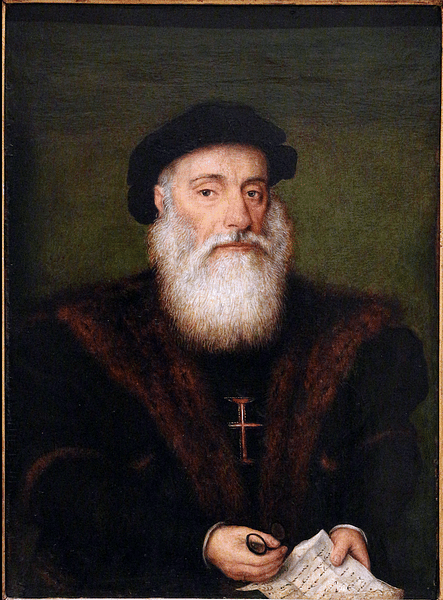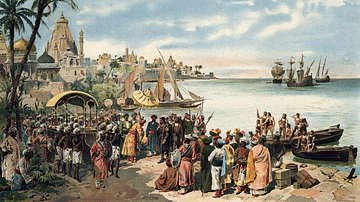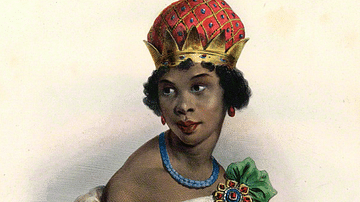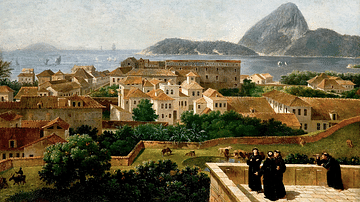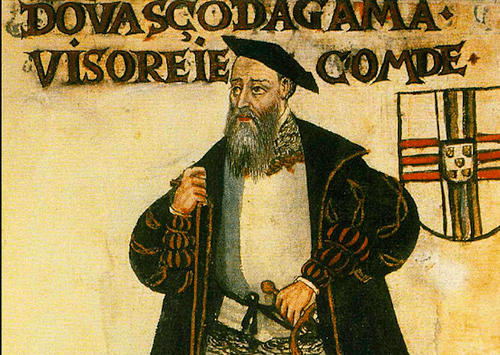
Vasco da Gama (c. 1469-1524) was a Portuguese navigator who, in 1497-9, sailed around the Cape of Good Hope in southern Africa and arrived at Calicut (now Kozhikode) on the south-west coast of India. This was the first direct voyage from Portugal to India and allowed the Europeans to cut in on the immensely lucrative Eastern trade in spices.
Da Gama repeated his voyage in 1502-3, but this time diplomacy took a back seat to cannon fire. The well-established patterns of trade in the Indian Ocean were changed forever as other European powers followed in da Gama’s wake and Europeans moved ever eastwards in search of riches. Da Gama became a legend in his own lifetime, and his rise to the very top of Portuguese society was confirmed when he was appointed Viceroy of Portuguese India in 1524. Sailing for a third time to India in 1524 to take up his new role, Vasco da Gama died of illness shortly after reaching Cochin (now Kochi) on the southwest coast.
Early Life
Vasco da Gama was born c. 1469 in Sines in the Alentejo region of Portugal. His father was Estêvão da Gama, a member of the minor nobility and his mother was Dona Isabel Sodré. Like his father, Vasco was involved in the Military Order of Santiago. He also became a member of the court of King Manuel I of Portugal (r. 1495-1521). Little is known about his early life and career except that he went on several military expeditions, likely serving in North Africa, and commanded a small fleet which captured French ships in several southern Portuguese ports in 1492. Quite why a relatively obscure figure benefitted from the king’s favour in being selected to command a major maritime expedition to the Indies is not known.
Preparation
The Portuguese Crown had already colonized with success three archipelagoes: Madeira (1420), the Azores (1439), and Cape Verde (1462) in the Atlantic off the coast of West Africa. The treacherous Cape Bojador was navigated in 1434, and it was discovered that ships with lateen sails and on a bold course out to catch winds and currents in the mid-Atlantic could safely be guided back home to Europe. In addition, from 1456, Portuguese mariners used a quadrant to measure their latitude position far from land by using the stars. The way south and east was finally open for those willing to take the necessary risks to get there.

In 1488 Bartolomeu Dias sailed down the coast of West Africa and made the first voyage around the Cape of Good Hope, the southern tip of the African continent (now South Africa). Dias planned a second, more ambitious voyage to find a direct sea route to India. However, command of this second expedition was awarded to Vasco da Gama; its primary purpose, as one crewman replied to the question "why are you here?" when he finally arrived in India: to find Christians and spices. The former aim rested on the conviction that somewhere in the east was a great Christian kingdom or several of them. These kingdoms could be useful allies against the Islamic states in the Middle East, long-time rivals to European powers in terms of religion and commerce. The Portuguese knew about the well-established trade being conducted in the Middle East between Asian, African, Muslim, and Italian states, a trade which already criss-crossed the Indian Ocean, the Red Sea, and the Middle Eastern land routes. Additional motives were to find food sources, Portugal being a net importer of foodstuffs at that time, to gain honour and prestige for the Crown, and to acquire wealth and glory for the mariners who risked their lives. The gathering of scientific and geographical knowledge was only deemed useful if it assisted the achievement of the expedition’s primary aims.
The funding for the expedition came from a mix of the Crown and private merchants, and it was not in any way lacking. Two ships were constructed specifically for the voyage: São Gabriel, to be commanded by da Gama, and São Rafael. The other two ships were the Berrio, a caravel, and, largest of the fleet, a 200-ton store ship. Amongst the captains chosen by da Gama were his own brothers Paulo and Nicolau Coelho, who would captain the São Rafael and the Berrio respectively. Another important member of the team was Dias’ chief pilot Pêro de Alenquer, who had valuable experience of the Cape. Finally, the hand-picked crew, which numbered no more than 170 men in all, was well-paid compared to other expeditions.
First Voyage to India
The Portuguese explorer set off from the mouth of the Tagus River near Lisbon on 8 July 1497 and reached the Portuguese colony of the Cape Verde Islands where he refitted and resupplied his ships. He left Cape Verde on 3 August and, instead of hugging the African coast, he sailed out westwards into the mid-Atlantic in a wide curve in the hope of catching favourable winds. As a result, the mariners spent a remarkable three months at sea without any sighting of land. Dias, in contrast, had hugged the West African coast and laboriously pushed against prevailing winds and currents.
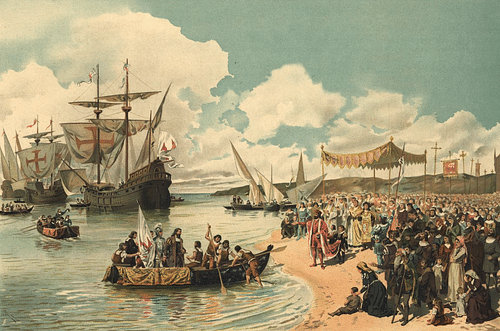
The monotonous routine of life at sea was now only broken by mealtimes:
The galley boy cooked the single daily hot meal over a sand-filled firebox on the deck, and the men ate the results off wooden trenchers with their fingers or pocketknives. Every crew member, from the captain down, received the same basic daily rations: a pound and a half of biscuit, two and a half pints of water, and small measures of vinegar and olive oil, together with a pound of salt beef or half a pound of pork, or rice and cod or cheese instead of the meat on fasting days. Delicacies like dried fruit were reserved for the top brass and would prove vital in preserving their health.
(Cliff, 174)
The small fleet finally swung back in eastwards, and they reached the southern tip of Africa on 7 November, several weeks quicker than Dias had managed. The ships were repaired, cleaned, and restocked at a bay they named St. Helena Bay. A meeting with Africans started well but descended into violence which saw several men wounded, including da Gama, shot in the leg by an arrow.
Rounding the Cape of Good Hope on 22 November, da Gama again stopped to take on fresh stores, this time at Mossel Bay. It was decided to break up the largest ship and redistribute the men and stores amongst the remaining three vessels of his fleet. The navigator then skipped up the coast of East Africa, stopping at the Islamic trading post of Quelimane amongst others.
Many of da Gama’s crew were suffering from scurvy by this time, then a new disease for European sailors and one whose cause and cure were unknown (a deficiency in Vitamin C). Arab sailors in Mombassa in East Africa, reached on 7 April, clearly knew about it and how to deal with it as they gave oranges to some crew members, and it was observed they made a speedy recovery. Unfortunately, nothing was done to prevent the disease returning as the voyage wore on. Da Gama then arrived at the Kingdom of Malindi on 15 April where he was given a pilot and a chart to help in the crossing to India. It has long been claimed that this pilot was the famous navigator Ahmad Ibn Masdjid (aka Majid), but this has since been disproved by scholars.

The explorers left Malindi on 24 April 1498 and crossed the Indian Ocean to arrive near Calicut on the Malabar coast on 18 May. The direct sailing route from Portugal to India had taken ten months. As was the habit of Portuguese sailors, pillars were erected - six in this case - to mark the landfalls of the expedition. The Portuguese did a little sightseeing such as visiting Hindu temples, although the visitors mistook Hinduism as some sort of odd branch of Eastern Christianity. Da Gama was able to communicate with the ruler of Calicut via the several fluent Arabic speakers he had in his crew who, in turn, worked with native Malayalam interpreters. A great disappointment, though, was the discovery that the Indians seemed perfectly content with their existing trade relations and remained rather sceptical of these new interlopers in odd clothing.
The ships took on board a quantity of precious spices such as pepper, ginger, cloves, and cinnamon, although really only a sample compared to future expeditions. In his role as ambassador, Da Gama tried to woo the ruler of Calicut, whom they called the zamorin, by exaggerating the great power of king Manuel and presenting some gifts. Unfortunately, inexperience here took its toll as da Gama’s gifts of clothing and foodstuffs were nowhere near as sumptuous as was the custom in this part of the world. There was also some irritation on the part of da Gama at the difficulties in organising several audiences with the zamorin and then convincing him that he came as an ambassador of a rich and powerful king. It seems relations deteriorated due to mutual suspicion and lack of communication. A number of Portuguese onshore were arrested, perhaps in a misunderstanding over the port’s departure tax. Fearing for the safety of his ships, da Gama took a number of hostages himself. These hostages were also useful to show the authorities back home that da Gama had indeed sailed to India. It was all a very unsatisfactory way of doing business, but next time, Portuguese cannons would do the talking, not ambassadors.
Return & Recognition
In October, da Gama recrossed the Indian Ocean, this time meeting a series of calms and storms. Scurvy struck again, leaving the ships short of able crew as over 30 men died. Returning to Malindi on 2 January 1499, the surviving crew members were revived but so many had succumbed to the disease that the São Rafael was abandoned for lack of crew to sail all the ships. The ruler of Malindi, eager to gather support in his rivalry with Mombassa, sent an ambassador so that he might meet the Portuguese king. The Portuguese left Malindi on 11 January. The Cape of Good Hope was rounded on 20 March 1499 and da Gama sailed on to make landfall in the Portuguese Azores. It was here that Paulo da Gama died.
The mariners eventually sailed back to Portugal, the ships arriving separately in July and August 1499 after what had been a terrible 11-month voyage from India. Of the 170-odd crew who had left Lisbon 732 days before, only around 55 made it back home. The remaining adventurers were at least given a great reception. To celebrate the success of da Gama’s voyage, the longest voyage ever undertaken in the history of navigation in terms of time and miles covered, King Manuel minted a massive new gold coin, the ten-cruzado known simply as the português. A celebrated account of the voyage, actually a diary or roteiro, was written by a crew member who is often identified as Alvaro Velho. Da Gama himself received a royal grant giving him possession of Sines and its various tax incomes, right of membership to the Royal Council, various maritime honours, the title of Admiral of the Indies, and the right to bear the title Dom before his name. By 1501, the Portuguese explorer had further increased his position in society when he married the noblewoman Dona Caterina de Ataíde.
The India Route is Established
The Portuguese now had a maritime route that allowed them to gain direct access to the riches of the East and cut out middlemen traders. In addition, it seemed (completely mistakenly) that there were Christian kingdoms in the east that could be useful allies against the Mamluk Sultanate. There had been some European trade contacts before with India, but the scale it would now reach was unprecedented. It is also true that this new development in world trade certainly did not put an end to the traditional Arabian land caravan routes from India to the Mediterranean. A second Portuguese expedition, this time with 13 ships and 1500 men and commanded by Pedro Álvares Cabral, set off to repeat da Gama’s feat in March 1500 and was given the brief of muscling-in on Muslim trade by sinking any Arab ships they came across. Cabral, trying to emulate da Gama's Atlantic route, sailed too far west and accidentally ‘discovered’ Brazil, which eventually became another Portuguese colony.
Second Voyage to India
In 1502-3, as the Portuguese Empire in the East became a reality, Vasco da Gama sailed a 15-ship fleet to Calicut (the fourth so far to be sent to the Malabar Coast by Manuel) in a revenge attack for the murder of a group of Portuguese led by Cabral, who himself had been guilty of atrocities in Calicut. Da Gama was also instructed by the Portuguese king to build a series of fortresses and to form a permanent fleet that could patrol and protect Portuguese trade interests there. The first of these forts was built at Cochin in 1503. To further promote Portuguese trade, da Gama asked the zamorin of Calicut to expel all Cairo and Red Sea Muslim traders from the city. The zamorin refused to alter his established trading partners.
Da Gama’s usual policy of attack first, trade second made him few friends, and his reputation was seriously damaged by an attack on a ship of over 300 pilgrims on their way to Mecca. Calicut was treated to a sustained barrage of cannon fire from the Portuguese fleet and there was a naval battle which the Europeans won. On the other hand, in that curious mix of trade and force, relations with Cochin further down the coast remained friendly. Increasingly, the whole Indian Ocean became a dangerous place to conduct trade as Indian, Arab, Dutch, Venetian, and Portuguese ships were not shy to use their cannons to get the better of their rivals.
Da Gama returned to Portugal on 10 October 1503 with a fleet laden down with precious spices, and it was rumoured the admiral had not been shy to fill his pockets with a fortune in gems and pearls. There was, too, the added bonus of a trade treaty and tribute from the ruler of Cochin, and a handsome gold tribute from the Muslim ruler of Kilwa on the Swahili coast. The Portuguese Crown remained hopeful of establishing regional dominance and a monopoly of trade one way or another and in 1505, a Viceroy of India was appointed, Francisco d’Almeida. The Portuguese moved ever-eastwards, even setting up a fort in China, although they did not then comprehend the might of the Ming Dynasty (1368-1644).
Death & Legacy
In April 1524, after a period of being out of royal favour (he was made a Count in 1519 but only after he threatened to defect to Spain), da Gama returns to the limelight when he sailed for a third time to India to take up his new role as viceroy. The old mariner had certainly clocked up some sea miles but he was seriously ill when he landed in November at what was now Portuguese Cochin. Taken to the house of a Portuguese settler called Diogo Pereira, Vasco da Gama there spent his final days. He died on Christmas Eve in 1524. He was interred in the Santo António church in Cochin, but his remains, as he had wished, were then returned to Portugal some years later. In the 19th century, his remains were then reportedly buried in the Jerónimos Monastery in Belém where a great many Portuguese monarchs were buried.
Those who followed in the wake of Dias and da Gama sought one thing: total control of the Indian Ocean trade network, then dominated by traders on the Swahili Coast of East Africa and Muslim traders from the Persian Gulf. With inferior weapons and a lack of cooperation between city-states, the Swahili Coast was not able to put up much of a defence. Fortresses were built, for example, at Sofala in 1505, Mozambique Island in 1507, and Shama in 1526. However, the Portuguese were such ruthless traders and so many settlements were razed and ships sunk that African traders moved northwards to avoid them. India, meanwhile, proved too big a territory to dominate but the Portuguese did establish trading centres all along the western coast of the subcontinent.
More generally, the voyages of Vasco da Gama to India and Christopher Columbus to the Americas in 1492 opened up the world to European exploration and colonization. The Portuguese went even further east, establishing colonies at Macau in China, at Nagasaki in Japan, and even visiting Korea. Empires rose, Europeans benefitted from a cheaper and more varied range of products, flora and fauna were shifted about the globe, diseases found new victims, and the lives of millions of indigenous peoples on four continents were changed forever.
